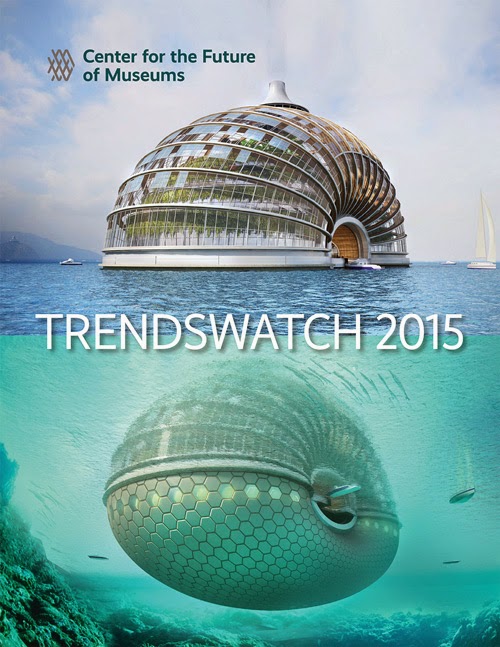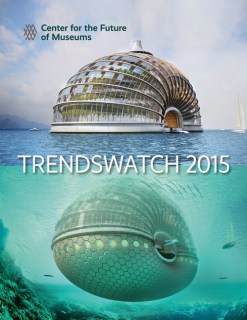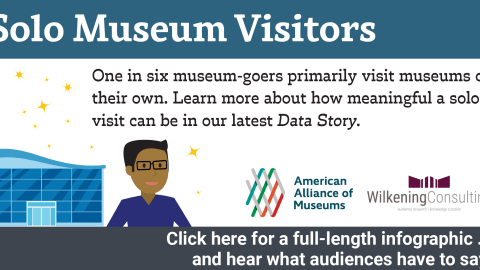
I want to say “Tada!” but I think all I have the energy for is “whew.” This year’s TrendsWatch is now available for download, and for the next week I’ll be hovering anxiously over my Twitter feed (#TrendsWatch), blogroll and e-mail to monitor your reactions. Please feel free to e-mail me directly as well–emerritt (at) aam-us.org.
This year the report focuses on:
- Open data, in the context of the growing culture of “open”
- The rise of ethical consumerism, powered by the web & by social media
- Personalizationof products, services, communications and experiences
- The changing seascape of museum risk due to climate change
- Wearable technologyin all its ingenious (and proliferating) permutations
- Slow culture
At some point after downloading the report you will receive an e-mail inviting you to provide feedback. Please take the time to respond, as this information is immensely usefulin helping the Alliance track how CFM’s materials are being used. (And build the case for support—thus enabling us to distribute the publication for free.)
I’ll be giving a session on the report at the AAM annual meeting on Tuesday, April 28 at 8:30 a.m. By then I will have an update on how these trends are playing out in the first third of this year. I look forward to hearing your questions and observations.
Without further ado, here is a preview of each of this year’s trends:
The “Open” Economy: filling the data pipeline
The open culture movement in all its permutations—open source, open software, open government—calls for a fundamental cultural shift from the assumption that information should be tightly controlled to the presumption that content should be made available to everybody, absent a compelling reason to keep it locked up. Open content licensing and Creative Commons copyrights encourage people to reuse, remix and redistribute material. Open source software invites programmers to mess with the underlying code. And the open data movement is racing to get information out in the world, where it can do some good. Governments are adopting open data policies and pouring money into creating open data infrastructure; companies are springing up to exploit these new resources; individuals are exploring how access to data sets empowers them as individuals, citizens and entrepreneurs. Museum data—cultural, scientific, especially operational—has traditionally been closely controlled. In a world pivoting towards open, can museums afford to be left behind?
Ethical Everything: managing the moral marketplace
Increasingly, the press and our peers remind us that each purchase we make and each bite we take has ripple effects on the world. The fact that, in this internet age, we couldresearch and vet the entire life cycle of a product or service, creates an expectation that we should. And this, in turn, leads to increased demand for transparency and accountability in behavior, sourcing and production. United and empowered by the Internet and by social media, today’s consumers wield unprecedented power, and woe betides any company that crosses the invisible ethical line. And nonprofits, traditionally assumed to be on the side of angels, don’t get a free pass in this era of soul-searching.
It’s Personal: one size does not fit all
The industrial era birthed the modern retail industry through the mass production of affordable goods. Handmade and bespoke items quickly became synonymous with luxury: only the wealthy could afford goods made to their personal measure. Now we’ve come full circle, as technology makes it relatively cheap and easy to personalize goods and services to each individual user, or use “mass personalization” to create the illusion of individual attention. This trend is playing out in three arenas: the creation of personalized goods, the filtering of personalized content, and the creation of personalized experiences. Audiences of the future, shaped by the broader marketplace, may expect museums’ products, communications and experiences to be tailored to their interests and needs.
A Rising Tide: The Changing Landscape of Risk
While politicians and pundits continue to argue about climate change, nearly everyone else—including oil companies, the insurance industry and the U.S. military—are buckling down to deal with reality. Despite Al Gore’s new found optimism about avoiding the worst consequences of climate change, we have a lot to work out. Over a century of data helps us plot the trajectory of change (in C02 levels, temperature, sea level) and model future ecologies, but the data can only inform our choices—they don’t give us answers. Whether and how to build, to move or abandon homes or whole communities, crafting the best approach to weathering storms and tides—planning on this scale will determine what cities and nations look like centuries from now, even as we deal with immediate consequences. Museums, as stewards of cultural heritage, are in it for the long term—to safeguard the artistic, historic and scientific resources they hold in trust for the public, museums need to adapt to a world where change, and water, are the new normal.
Wearable Tech: when “bring your own device” means shirt and shoes
2014 was declared by some to be the “Year of the Wearable Technology Boom,” as functions that currently reside in our computer, tablet or phone migrated to our body and our clothing. Wearable tech is about seamless integration, invisibility and blending technology into everyday life. Tech is a wearable win when it becomes an unremarkable part of what we put on each morning. What that technology does is all over the map. Many wearable devices currently focus on biometric analysis (medical data, quantified self, life-logging), but more broadly “wearables” can integrate any technology (social media, communications, data analytics) onto and into our bodies. The creativity and attention being lavished on hand-held mobile technology may migrate, with time, into wearable tech. And as it does, technology that used to be something we had to pick up, turn on, and remember to take with us will become psychologically integrated into our physical self.
Slooow: when it’s better to be tortoise than a hare
In the past few decades there’s a growing awareness that while “fast” may look efficient, in the end it may not be effective. The “Slow Movement,” composed of distributed, disaggregated individuals and groups advocating similar principles across a range of sectors, represents a cultural shift towards a slower pace of life. It came to world attention in the 1980’s when Carlo Petrini founded the “Slow Food” movement in Italy (now it is international), in large part to fight globalization of food and agriculture and the destruction of local economies and traditions. Now (ironically) the movement is gathering speed, and “slow” is being applied as a business strategy and life philosophy to everything from food to travel to health care, as we rediscover that doing something quickly doesn’t always mean doing it right.
I hope you enjoy giving the whole text a (slow) read.
Yours from the future,
Elizabeth










I know what I'm doing this weekend – just downloaded AAM's Trendswatch 2015. I always look forward to this important annual report and frequently use it in my classes. Thanks, Beth! #feelthelove
Congratulations on another thought-provoking TrendsWatch, Liz! And thanks for highlighting Hull-House's Slow Museum Project.